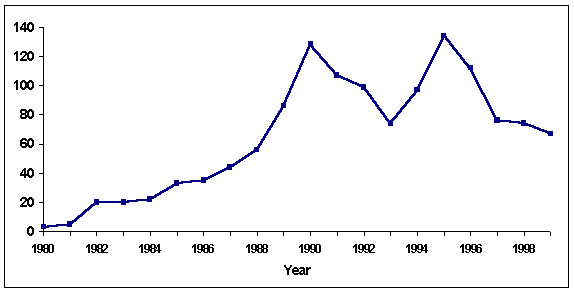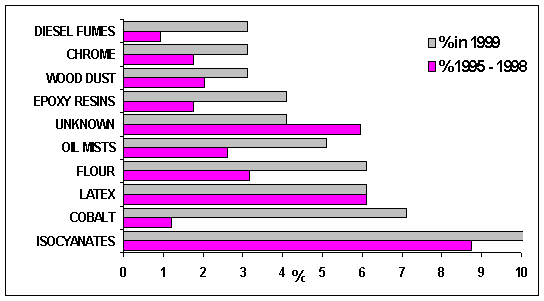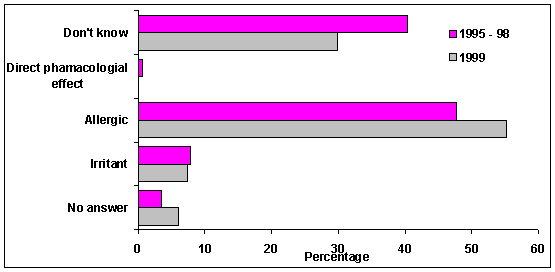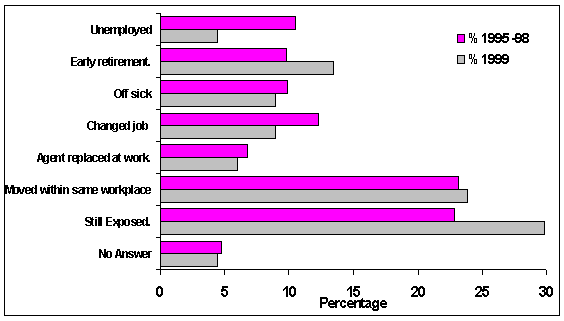Shield Report 1999; A Surveillance Scheme of Occupational Asthma in the Midlands |

|
C Catton, W Anees, and PS Burge.
Occupational Lung Disease Unit, Heartlands Hospital, Bordesley Green East, BIRMINGHAM B95SS.
SHIELD is the Midland Thoracic Society's Rare Respiratory Disease Registry Surveillance Scheme of Occupational Asthma (OA). The scheme, which was set up in January 1989, was established to study the general and specific incidence of OA within the West Midlands region and Metropolitan County. 67 cases of OA were diagnosed in 1999. This is a fall of 9.5 % from 1998. The most common cause of OA in 1999 were isocyanates (13%). 95.5% of cases reported in 1999 were by the Birmingham Chest Clinic, and 4.5% by others. In the years between 1995-98 an average of 25.5 % of cases were being reported by other organisations. The most common method for the diagnosis of OA still remains a history of improvement of symptoms during holidays or periods off work. Only 7.5% of cases had a specific bronchial challenge test. 56.7 % of the cases reported in 1999 were believed to be due to an allergic mechanism, whilst in 30% of cases the mechanism was unknown. 28% of the patients diagnosed in 1999 are still exposed to the agent at work, and 24% have been relocated so they are no longer exposed to the agent at work.
Introduction
Shield is the Midland Thoracic Society's Rare Respiratory Disease Registry Surveillance Scheme of Occupational Asthma. The scheme, which was set up in January 1989, was established to meet three main objectives. 1) To study the general and specific incidence of occupational asthma within a defined geographic area, 2) To determine proposed mechanisms of asthma, and 3) to determine the employment state of workers at diagnosis2. Chest physicians, the Medical Boarding Centre (respiratory disease), and members of the West Midlands Group of the Society of Occupational Medicine1 implemented the scheme, by reporting each new case using a questionnaire format. The questionnaire covers personal information on the patient, details of the diagnosis, information about their occupational history, and the outcome after diagnosis.
The last report on Shields progress was written in 1995 and summarised the information gained in that year, to that of previous years1. This report aims to update the participants of Shield by summarising the trends found in 1999 compared to those found in the years of 1995 to 1998.
Results
Personal Details
In the year of 1999, 67 new cases were reported to the scheme. There were 45 males (67.2 %), and 22 females (32.8 %). 48 (71.6 %) of the new cases had no pre-existing asthma, and 28 (41.8 %) were ex smokers.
The number of cases of occupational asthma reported to the Shield scheme has dropped since the peaks of 1990 and 1995 where 128 and 134 cases were reported respectively (Figure 1).
Figure 1 Number of cases diagnosed with occupational asthma between the years of 1980 and 1999.

Reporting Hospital and Physician
The Shield scheme is confined to the West midlands Region and West Midlands Metropolitan County. In this region there are many chest physicians, hospitals, clinics and other organisations, which are known to the Shield scheme. However in the year of 1999, 64 (95.5 %) of the cases reported to Shield were through the Birmingham Chest Clinic, and 3 (4.5 %) through other organisations. The percentage of cases being reported by the BCC each year (since 1995) has increased from 67.9 to 95.5%. This shows that during previous years (1995 to 1998) there was a much greater contribution by others, an average of 25.3 cases were being reported each year from a combination of 34 different organisations. However most cases were still being reported by the Birmingham Chest Clinic with 74.5 % (295) of all the cases between 1995 and 1998.
Suspected agents at work
In 1999 the reported agents that the workers were exposed to had varied from the previous years. The most common in 1999 and previous years (except 1997) were isocyanates. 255 cases of isocyanate suspected asthma have been reported to the scheme, the first case was in 1978. 13 cases of isocyanate asthma were reported in 1999 and 71 cases between 1995-98. The top eleven agents reported in 1999 were; 1) Isocyanates (13%), 2) Cobalt (7%), 3 & 4) Latex and flour (6%), 5) Oil mists (5%), 6 & 7) Unknown, & Epoxy resins (4%), 8 to 11) Chrome, Diesel fumes, Wood dust and amylase (3%). Isocyanates, latex, flour, and unknown are in the top ten agents exposed each year since 1995. Colophony and glutaraldehyde are not in the top ten agents exposed in 1999, but they were both present in the top ten agents between 1995 and 1998. Cobalt, and diesel fumes are in the top ten agents for 1999 for the first time. The list of top ten agents of each year has been compiled from only 19 agents during 1995 to 1999. 14 new agents were reported to Shield in 1999, each agent has only been reported once to date.
Figure 3 Number of cases diagnosed with occupational asthma between the years of 1980 and 1999.

Employers and Jobs
There were 52 different employers reported to the scheme in 1999, with only 2 unknowns. 27 of these employers were new to the scheme. There were two outbreaks from places of employment highlighted by the scheme in 1999. These employers were responsible for 9.0%, and 10.4% of cases reported to the scheme during 1999 but only 5.4% and 2.7% in 1998 respectively. The jobs of the patients from these two establishments were varied.
38 different jobs were reported in 1999. The most common jobs were nurses (10.4%) and paint sprayers (9.0%). 10.4% of jobs were unknown.
Table 1 A list of agents reported in 1999 with the corresponding jobs.
| Agent Exposed |
Job |
| 305 |
Shoe Maker |
| Aspugillus Fumigatus |
Packer |
| Carpet |
Sewing Machinist |
| Cat |
Kennel Worker |
| Chloramphenicol |
Nurse (ENT) |
| Chrome |
Process operator, welder |
| Cigarette Smoke |
Healthcare Assistant |
| Cobalt Chloride |
Polisher, setter, grinder, plasma sprayer, welder |
| Colophony |
Unknown |
| Coolant Oils |
Engineer, grinder, Unknown |
| Cyanacrylate |
Gasket Operator |
| Dichloralate |
Unknown |
| Diesel Fumes |
Driver |
| Epoxy Resins |
Pattern Maker, Tester/packer |
| Fabric Dust |
Textile Technician |
| Floor Cleaner |
Power Press Operator, caretaker |
| Flour |
Baker, Maintenance Fitter, Packer |
| Glutaraldehyde |
Lab Technician, Nurse (theatre) |
| Isocyanates |
Assembler, Roofer, Labourer, Electrician, Sheet, metal worker, Lorry Driver, Moulder |
| Latex |
Nurse, Doctor |
| Nitrogen Trichloride |
Nurse (ITU) |
| NuCidex |
Nurse (theatre) |
| Perchloroethylene |
Unknown |
| Printing inks |
Printer |
| Perfumes |
Packer |
| Unknown |
Shot Blaster, paint sprayer, Powder Coater, Viewer, Unknown |
| Urea Formaldehyde |
Chemist |
| Wood Dust |
Carpenter, Electrician, Joiner |
| Zintec |
Welder, Engineer |
Methods used for diagnosis
The methods used for the diagnosis of occupational asthma vary between each hospital and each physician. The methods that are documented on the shield form are; 1) Improvement on holiday, 2) Improvement off work, 3) Serial peak flow charts, 4) Specific IgE, 5) Methacholine at work, and 6) Methacholine away from work and 7) Bronchial provocation tests. 59 cases were documented as improving off work and on holidays. Of these 59, 53 cases had at least one other investigation. The most common investigation was serial peak flow chart (43 cases) followed by IgE (34 cases). In the year of 1999 the percentage trend in the methods used was consistent with the trend found between 1995 and 1998. There were 5 (7.5%) bronchial provocation tests in 1999, which is a drop from 8.1% in the years 1995-98. The number of bronchial challenges peaked in 1997 with 10 challenges for that year.
Table 2 Percentage use of each method of diagnosing occupational asthma in 1999 and 1995-1998.
| Method |
% 1999 |
% 95-98 |
| Improving on holidays |
89.6 |
87.6 |
| Improving off work |
92.5 |
86.6 |
| Serial peak flow |
73.1 |
68.7 |
| Specific IgE |
56.7 |
47.5 |
| Methacholine at work |
26.9 |
15.7 |
| Methacholine away from work |
50.7 |
32.1 |
| Specific Bronchial |
7.5 |
7.8 |
Proposed method of Asthma
Figure 4 shows the proposed mechanism of asthma in patients with diagnosed occupational asthma in 1999 and between 1995-98. In 1999 the most commonly reported mechanism of asthma was allergic 38 (56.7 %). Between the years of 1995-98 allergic was also reported in most cases, however the overall percentage was less (47.0 %). The percentage of the cases where the mechanism is not known is lower in 1999 (29.8 %) compared to the previous 4 years (40.9 %), but the percentage of 'no answer' to the proposed mechanism for asthma has increased in 1999 compared to the previous 4 years. The other mechanisms (irritant and direct pharmacological effect) still remain low in the percentage of proposed mechanisms.
Figure 4 Proposed mechanisms of asthma in 1999 and between 1995-98.

Subsequent History
The subsequent history of the patients diagnosed with occupational asthma in 1999 seems to be better than for patients of previous years. Although a greater percentage of patients are still exposed to the agents at work or have received early retirement, there is a decrease in the percentage of unemployed and off sick. Relocation in the work place has increased and still remains the most popular solution. The percentage of 'no answer' has decreased from previous years. The recorded subsequent history of the patient is taken at diagnoses and may be changed as investigations occur, this means that the form should be updated and the true outcome for the patients diagnosed with occupational asthma in 1999 will not be seen until mid 2000.
Figure 5 Subsequent history of patients diagnosed of occ. asthma in 1999 and between 1995-98.

Gold Standards
A gold standard occupational asthma case is defined by either; 1) Bronchial challenge test, 2) A four fold change in their bronchial reactivity with a good history, or 3) Positive IgE with a good history. 10.4% of cases in 1999 were gold standard which is consistent with 1998. However as gold standard is dependent upon the results of investigations it is likely that this will rise over the next year.
Future Developments
This report has highlighted the problems in the Shield scheme to be a lack of reporting and a need for constant updating. The reduction in the number of reported cases is partly due to the sickness of the secretary responsible for the rare disease registry and partly to the fatigue and lack of awareness of the scheme. However reporting from the region has increased following the new rare disease form. Also the number of 'no answers' to questions implies that the results of further investigations are not being reported. To try and solve the above problems it is believed that a two-part questionnaire will help. The initial questionnaire could have the personal details of the patient and the details of their employment with suspected agents. Once this is received a printed copy will be sent back with the above details plus a reported date. The printed sheet will be an advantage to the physician, as they will know that it has been reported. Included on the printed sheet would be the remainder of the questions and an advised 2nd reporting date. This will enable the physician to complete the form as and when the investigations are carried out, and to send the form back when completed or by the 2nd reporting date. Using this method it will be clear in the notes if the patient has been reported, at what stag the investigations are at whilst maintaining an up to date data base.
Comments
Please sign in or register to add your thoughts.